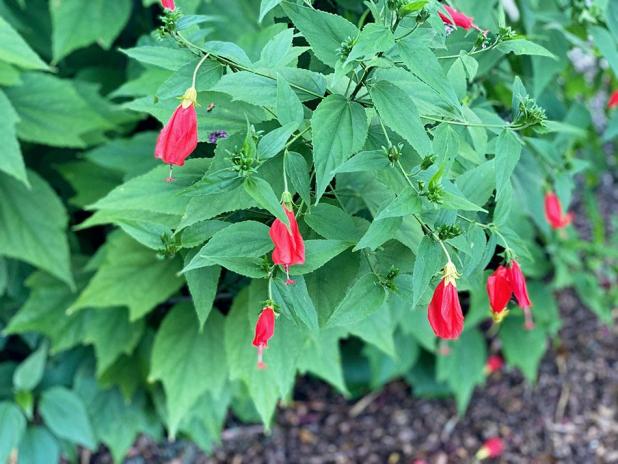
Turk’s cap is a hummingbird favorite with its red tubular flowers. It makes an excellent flowering shrub for the landscape. Red tubular flowers are a food magnet for hummingbirds.
—LSU AgCenter/Heather Kirk-Ballard
Get It Growing: Fall flowers for hummingbirds
Take a look around and you’ll see that many flowering perennials are beginning their fall bloom. One of the greatest admirers of these plants is the hummingbird, along with other pollinators.
This is good news for the hummingbirds as they prepare for their fall migration to warmer climates in Central America. You may see a few stopping to refuel on their migration this month and into early October. If the food is plentiful, some hummingbirds overwinter in southeastern coastal states such as ours.
Many flowers produce a sugary fluid called nectar to encourage pollination by insects and other animals. This is what bees use to make honey. It consists of a water solution of sugars such as fructose, glucose and sucrose along with other nutrients. Some plants are better producers than others.
Hummingbirds need more than nectar to survive, however. They also need protein that they get from eating small insects such as fruit flies, gnats and mosquitos, and luckily these insects also live on the plants that grow in our landscapes.
If you want to enjoy more hummingbirds and supply delicious food for them, you can do so by incorporating more flowering plants that produce nectar into your landscape. Many of those plant species are perennials that come back year after year, meaning they become a semipermanent fixture in your garden and landscape and will lure the hummingbirds back each year.
Hummingbirds are especially attracted to tubular-shaped flowers with vibrant colors. The color red is especially enticing. Many perennial bedding plants and flowering shrubs and trees offer excellent nectar sources for hummingbirds.
Some excellent flowering plants for hummingbirds are sages such as anise, pineapple and scarlet sages in addition to flowering maple (Abutilon sp.) and firebush (Hamelia patens). These in particular have ample nectar.
Some other recommended plants are agastache (Agastache sp.), catmint (Nepeta sp.), cry-baby tree (Erythrina crista-galli), bottlebrush (Callistemon citrinus), firecracker plant (Cuphea ‘Vermillionaire’), firecracker vine (Manettia cordifolid), gingers (Hedychium sp.), red hot poker (Kniphofia), red canna lily (Canna coccinea), salvias (any species) and shrimp plant (Justicia brandegeeana).
Natives are always an excellent option. Some natives to incorporate are bee balm (Monarda bradburiana), cardinal flower (Lobelia cardinalis), coral bean (Erythrina herbacea), coral honeysuckle (Lonicera sempervirens), copper iris (Iris fulva), cross vine (Bignonia carpreolata), cupheas, firecracker plant (Russelia equisetiformis), penstemon (Penstemon sps), trumpet honeysuckle (Lonicera sempervirens), trumpet vine (Campsis radicans) and Turk’s cap (Malvaviscus arboreus “Drummondii”).
Hummingbirds that decide to overwinter in your landscape will need protection in the wintertime, so be sure to offer evergreen shrubs and trees such as arborvitae, camellias, hollies, inkberry, junipers, magnolias, red bay, sweet olives and viburnum where they can nest during colder temperatures. Many folks recommend taking down hummingbird feeders during the fall to encourage hummingbirds to carry on with their migration.
Plants can be added to any landscape to provide ecosystem services to wildlife. When the hummingbirds have moved on, several other important pollinators — including bats — will continue to benefit from your landscape. Help support our wildlife friends with plants that add aesthetic beauty to your landscape and provide habitat and food for them.
An excellent resource on the subject of feeding birds is the book “Attracting Birds to Southern Gardens” by Thomas Pope, Charles Fryling Jr. and the late Neil Odenwald. In addition, the Baton Rouge Audubon society (braudubon.org) and Audubon society (audubon.org) offer a wealth of useful information.
